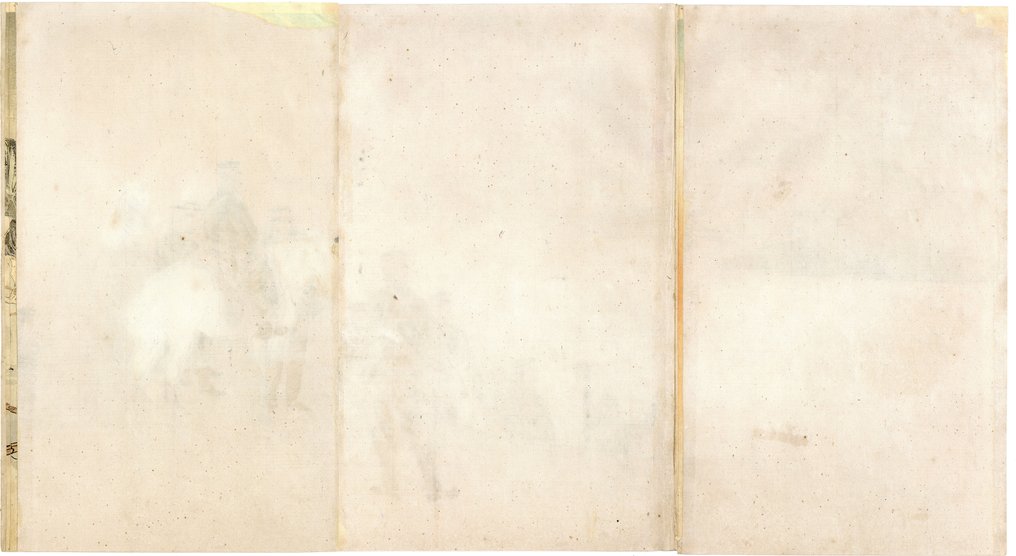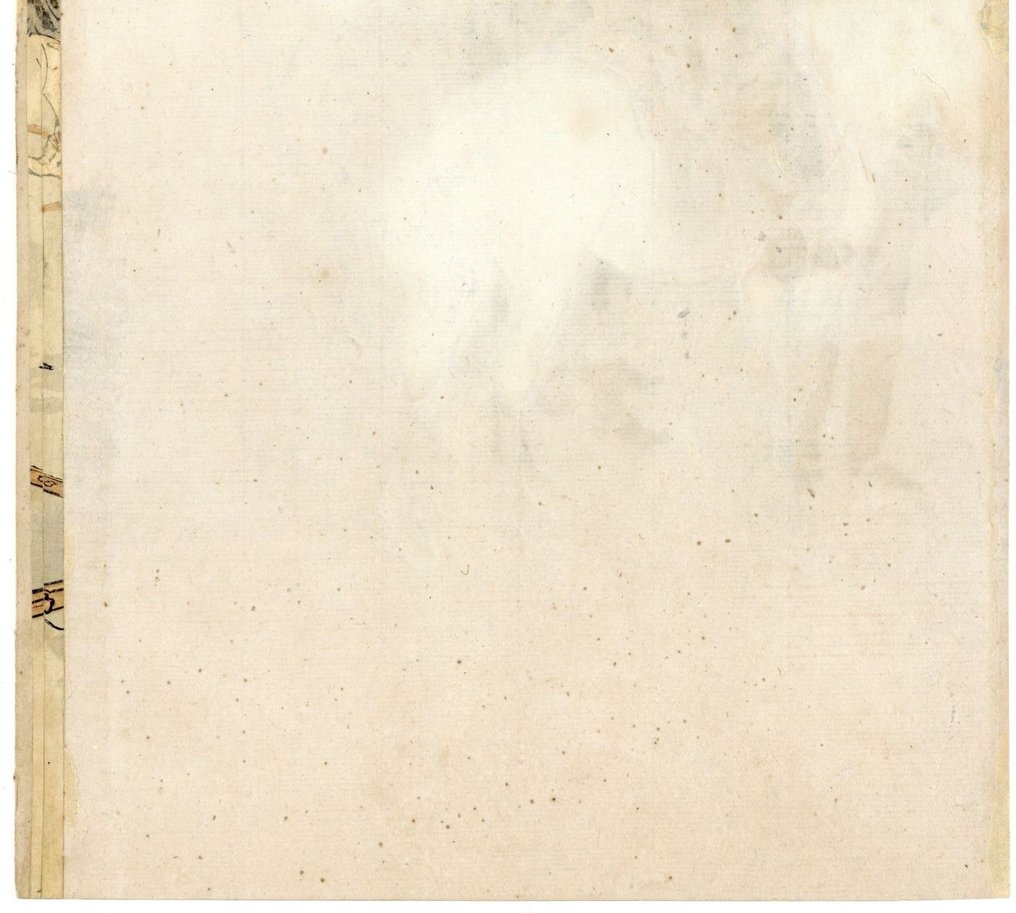Objet conforme. Emballage parfait
Übersetzung ansehen'The Battle at Tian-Chuang-Tai: The Gathering of Eleven Generals' 田庄台之役 将校十一名同所に会す - 1895 - Ogata Gekko (1859-1920) - Japan - Meiji Periode (1868-1912)
Nr. 85695589





Original woodblock print triptych - Paper - Ogata Gekko (1859-1920) - “Denshōdai no yaku shōkō juuichi mei dōsho ni kaisu” 田庄台之役 将校十一名同所に会す (The Battle at Tian-Chuang-Tai: The Gathering of Eleven Generals) - Japan - 1895 (Meiji 28)
See Museum of Fine Arts, Boston: https://collections.mfa.org/objects/129926
Publisher by Takegawa Tonesaburou 武川利根三郎
The triptych depict the fall of Fengcheng Fortress in Liaoning to the Japanese army during the -Qing Japanese war of 1894-95.
Also, since it is old, there are stains and marks on the tape. There is a tape mark on the back of the woodblock print (the prints are secured together). Paper losses and creases
The signature says “Gekko”月耕”.
Gekko often works on works that have a sense of life and are based on everyday life and festivals. The work he exhibited this time is one of them.
Gekko was a disciple of Kikuchi Yosai.
Therefore, unlike the Ukiyo-e artists of Tsunobu, Yoshitoshi, and Kunisada.
Kikuchi Yosai learned Japanese painting from Tosa(土佐派) and Shijo(四条派) painters.
Gekko learned painting from Yosai, so his style is also influenced by it.
memo
He was born as Nakagami Shōnosuke (名鏡 正之助) in Kyōbashi Yazaemon-chō in Edo (modern Tokyo) in 1859.
Gekkō was self-taught in art, and began decorating porcelain and rickshaws, and designing flyers for the pleasure quarters.
From the 1890s Gekkō won a number of art prizes, both national and international. He was one of the earliest Japanese artists to win international attention. At the World’s Columbian Exposition in Chicago in 1893 he won a prize for Edo Sannō matsuri (江戸山王祭, “Edo’s Sannō Festival”), and in 1904 he won the Gold Prize for the series Fuji hyakkei (富士百景, “One Hundred Views of Mount Fuji”) at the Louisiana Purchase Exposition. His work was exhibited at the Exposition Universelle in Paris in 1900 and at the Japan-British Exhibition in London in 1910.In 1898 at the Japan Art Association, Emperor Meiji bought his painting Soga yo-uchi (曽我夜討, “Night Attack of the Soga”). He won third prize at the sixth Ministry of Education Art Exhibition in 1912.
Original woodblock print triptych - Paper - Ogata Gekko (1859-1920) - “Denshōdai no yaku shōkō juuichi mei dōsho ni kaisu” 田庄台之役 将校十一名同所に会す (The Battle at Tian-Chuang-Tai: The Gathering of Eleven Generals) - Japan - 1895 (Meiji 28)
See Museum of Fine Arts, Boston: https://collections.mfa.org/objects/129926
Publisher by Takegawa Tonesaburou 武川利根三郎
The triptych depict the fall of Fengcheng Fortress in Liaoning to the Japanese army during the -Qing Japanese war of 1894-95.
Also, since it is old, there are stains and marks on the tape. There is a tape mark on the back of the woodblock print (the prints are secured together). Paper losses and creases
The signature says “Gekko”月耕”.
Gekko often works on works that have a sense of life and are based on everyday life and festivals. The work he exhibited this time is one of them.
Gekko was a disciple of Kikuchi Yosai.
Therefore, unlike the Ukiyo-e artists of Tsunobu, Yoshitoshi, and Kunisada.
Kikuchi Yosai learned Japanese painting from Tosa(土佐派) and Shijo(四条派) painters.
Gekko learned painting from Yosai, so his style is also influenced by it.
memo
He was born as Nakagami Shōnosuke (名鏡 正之助) in Kyōbashi Yazaemon-chō in Edo (modern Tokyo) in 1859.
Gekkō was self-taught in art, and began decorating porcelain and rickshaws, and designing flyers for the pleasure quarters.
From the 1890s Gekkō won a number of art prizes, both national and international. He was one of the earliest Japanese artists to win international attention. At the World’s Columbian Exposition in Chicago in 1893 he won a prize for Edo Sannō matsuri (江戸山王祭, “Edo’s Sannō Festival”), and in 1904 he won the Gold Prize for the series Fuji hyakkei (富士百景, “One Hundred Views of Mount Fuji”) at the Louisiana Purchase Exposition. His work was exhibited at the Exposition Universelle in Paris in 1900 and at the Japan-British Exhibition in London in 1910.In 1898 at the Japan Art Association, Emperor Meiji bought his painting Soga yo-uchi (曽我夜討, “Night Attack of the Soga”). He won third prize at the sixth Ministry of Education Art Exhibition in 1912.
- 210
- 4
- 2
Keurig en netjes afgehandeld
Übersetzung ansehenThumbs up to Japan's postal system! Efficient and fast, the seller packs the items carefully and is very professional.
Übersetzung ansehenPerfect seller! Thank you very much from Germany!
Übersetzung ansehentodo bien
Übersetzung ansehentutto perfetto grazie
Übersetzung ansehenComme toujours, le bien vendu est tout à fait conforme au descriptif, de très bonne qualité et a été très bien emballé. Je recommande vivement ce vendeur.
Übersetzung ansehenGood seller fast shipment very well packed
Übersetzung ansehenErg mooie, kleurrijke print. Heel blij mee!
Übersetzung ansehenPerfect! Again thank you very much from Germany!
Übersetzung ansehenbedankt voor deze mooie houtblokprinten.
Übersetzung ansehenGreat print and good delivery
Übersetzung ansehenMuy bien. Muchas gracias. Thank you !!
Übersetzung ansehenTop marchandise merci pour la rapide livraison
Übersetzung ansehenBedankt voor deze oude prenten. Kan professioneler verpakt worden.
Übersetzung ansehenFast shipment and carefully packed (as usual). Beautiful woodprint. Arigato gozaimasu.
Übersetzung ansehenDelivery a little long but well packaged and as described. Satisfactory
Übersetzung ansehenAnything is fine. Many thanks from Germany.
Übersetzung ansehenspedizione molto veloce e imballaggio molto accurato. Stampe molto belle e descrizione conforme. Soddisfatto pienamente.
Übersetzung ansehenFast shipment, carefully packed and wonderful woodprints. Thank you!
Übersetzung ansehenFast shipment, carefully packed and a very nice print.
Übersetzung ansehenMerci tout est parfait 🙏🏽
Übersetzung ansehenVery Fine Japanese Triptych! Fast, Safe & Cheap Shipping!!!
Übersetzung ansehenFine wood print, fine packaging, quick delivery. Many thanks. CLaval, France (EU)
Übersetzung ansehenTHANK YOU VERY MUCH
Übersetzung ansehen- 210
- 4
- 2
Objet conforme. Emballage parfait
Übersetzung ansehen








